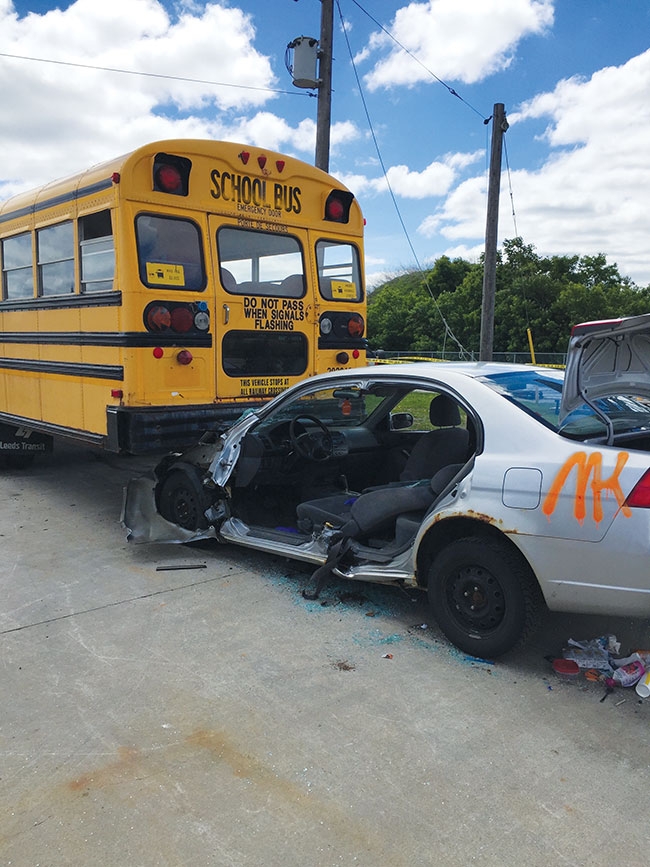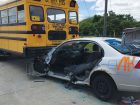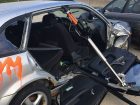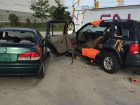
Extrication Tips
By Chad Roberts
Features Extrication TrainingIn past articles, I have stressed the need for more than one plan for every extrication scene. Every call we go to will inevitably be different with different vehicles involved. Different speeds, directions, occupant load and even weather can lead us to the fact that there is very little about our scenes that will be the same.
 The view of a full-side removal using the simple step-by-step method. Some options for full-side removal
The view of a full-side removal using the simple step-by-step method. Some options for full-side removalSo, when choosing our plan we must remember that our plan B is always worth going to when things go awry.
In this article, though, I would like to address a focused initial assessment when doing a “full-side removal” of a passenger vehicle.
There are many different variations of the full-side removal. There is the simple “step-by-step, separate door” removal and finally cutting out the B post. There is also the “full-side, fold-down” and the “B pillar rip.”
All of these have relatively the same result. But, what is truly best? The answer is not so clear. And, in order to choose the right option, we must quickly compile various amounts of information from our accident scene to make the proper choice. By not doing this we can find ourselves in a dead end, possibly inflicting more pain on our patient, or even contradicting further operations such as the “dash roll.”
For continual assessment to truly be successful, it should not just be on the shoulders of the incident commander (IC) or the rescue sector captain. It needs to be a concerted effort by all those on scene. The IC must have a look at things like point of impact, metal intrusion into the passenger area and placement of the patient to get a really good idea of how to go about doing a side removal.
The IC must also make sure the medic or firefighter in charge of patient care enters the vehicle in a timely fashion in order to get a good look at the level of intrusion and patient entrapments. This is truly the most important information that must be processed in order to choose the proper plan.
And, finally, the input from firefighters operating the tools from the outside will have a vantage point on how things really are going. The reaction of the tools with crushed metal can be a make or break point as to whether the original plan is working or a different version of a full-side removal must be done.
So, let’s start with the most basic option of the full-side removal. This can be accomplished by first removing the front and back door separately and completely. Once this is done, the B post can be removed entirely to create a large void in the side of the vehicle.
Although this may not be the most technically appealing option and can take a little more time removing each door individually, it can serve as a valuable option. Leaving the B pillar until the end will allow you the final option of doing a dash roll with the ram if you find the patient’s legs are trapped.
If not identified early enough and the B pillar is removed, you will be stuck with doing a dash lift with the spreaders, which may not always work depending on the degree of frontal intrusion. I will write about this in my next article. This is where communication and quick observation by your interior patient-care firefighter are key to advise whether the B post will be needed for the ram push.
Another option for side removal is what most in our industry refer to as the “B pillar rip.”
This is accomplished by forcing open the rear door. At the bottom of the B post a cut is made. Using the spreaders, one arm is placed along the rocker channel and the other is placed against the bottom corner of the back door. By spreading at these points, it will cause our first bottom B pillar cut to tear along the bottom rocker channel and subsequently detach, leaving the B post only attached at the roof.
From here, you can finally cut the top B post, removing the back door, B post and front door all in one piece. It is very important to note that cutting the top of the B post before the bottom will not only take away the strength needed for the rip to occur, but will also cause the loose top of the B post to drive into your patient’s head.
The front door can be removed at the hinges or merely tied back if time is of the essence. This large opening created is the same as our first option, but merely requires fewer cuts. Although less time-consuming, this move does require more technical skill and, much like the first option, a realization of patient placement and entrapment.
Simply stated, if there is a significant amount of side impact intrusion it may be more beneficial to go with our final option, the B post lay down. The reason is that this option will afford less of an opportunity for the door or material impacted to be pushed back on our patient by removing it down and away from the patient.
To complete the lay down, the back door must be forced at the Nader pin similar to the B pillar rip, but in this operation the front door is to be forced simultaneously at the hinges, leaving the front and back door attached only at the B pillar. From there we cut the top of the B post, and use the spreaders inserted into this cut to force the B pillar and doors down towards the ground. Once the spreader is maxed out, the ram can be brought in to finalize the B pillar push all the way to the ground.
While all of these options provide a similar result, it must be remembered that there is no one best method for a side removal. However, with proper interior patient entrapment size-up, and a good look at outside vehicle impact intrusion, we can make a better decision on what is best for the patient.
Like anything else in the fire service, there are many different ways to accomplish similar tasks. By breaking methods down into what they truly achieve, we can begin to appreciate each method individually for what we need at each scene.
Chad Roberts is a firefighter in Oakville, Ont. He is a member of the Oakville extrication team and competes and trains across North America. Contact Chad at chadroberts12@gmail.com.
Print this page


